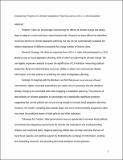Explaining Progress in Climate Adaptation Planning Across 156 U.S. Municipalities
Author(s)
Shi, Linda; Chu, Eric; Debats, Jessica
DownloadJAPA_2ndRevision_Main_Text.pdf (233.3Kb)
Publisher Policy
Publisher Policy
Article is made available in accordance with the publisher's policy and may be subject to US copyright law. Please refer to the publisher's site for terms of use.
Terms of use
Metadata
Show full item recordAbstract
Problem, research strategy, and findings: Cities are increasingly experiencing the effects of climate change and taking steps to adapt to current and future natural hazard risks. Research on these efforts has identified numerous barriers to climate adaptation planning, but has not yet systematically evaluated the relative importance of different constraints for a large number of diverse cities. We draw on responses from 156 U.S. cities that participated in a 2011 global survey on local adaptation planning, 60% of which are planning for climate change. We use logistic regression analysis to assess the significance of 13 indicators measuring political leadership, fiscal and administrative resources, ability to obtain and communicate climate information, and state policies in predicting the status of adaptation planning. In keeping with the literature, we find that greater local elected officials commitment, higher municipal expenditures per capita, and an awareness that the climate is already changing are associated with cities engaging in adaptation planning. The presence of state policies on climate adaptation is surprisingly not a statistically significant predictor, suggesting that current policies are not yet strong enough to increase local adaptation planning. However, the model's sampling bias toward larger and more environmentally progressive cities may mask the predictive power of state policies and other indicators.Takeaway for practice: State governments have an opportunity to increase local political commitment by integrating requirements for climate-risk evaluations into existing funding streams and investment plans. Regional planning entities also can help overcome the lack of local fiscal capacity and political support by facilitating the exchange of information, pooling and channeling resources, and providing technical assistance to local planners.
Date issued
2015-07-03Department
Massachusetts Institute of Technology. Department of Urban Studies and PlanningJournal
Journal of the American Planning Association
Publisher
Informa UK Limited
Citation
Shi, Linda, Eric Chu, and Jessica Debats. "Explaining Progress in Climate Adaptation Planning across 156 Us Municipalities." Journal of the American Planning Association 81 3 (2015): 191-202.
Version: Author's final manuscript